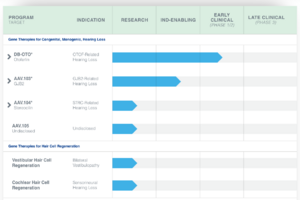Gene Mutations
Both Julie and I are carriers of a gene mutation in the GJB-2 gene. This makes it quite likely that our children will have what is called non-syndromic hearing loss, i.e. they will be born deaf or hard of hearing without other changes to the body.
GJB-2 Gene Problems
The Gap Junction[1]Protein Beta-2 (GJB-2) gene codes for[2] the protein Connexin-26. As you can imagine, a protein can break in many ways. One common way is for it to be incomplete because a mutation in the gene that codes for it causes it to be not fully formed.
Here's one of the gene mutations we have in GJB-2: NM_004004.6:c.71G>A p.(Trp24Ter). Interpreted, this tells us that in the GJB-2 gene, at position 71, a nucleotide G was replaced by a nucleotide A. This transforms the template from TGG (add Tryptophan to the chain) into TGA (a stop codon) at position 24. This silly typo in the code causes the resulting attempt at making Connexin-26 to stop at the 24th amino acid, resulting in this 23-amino-acid long protein that is unlikely to do the job because it's supposed to be 226 amino-acids long.
A single mutation won't destroy hearing[3], but two of this will be catastrophic because there's no way to make a functioning Connexin-26. The reason why Connexin-26 is particularly necessary here is in its role in maintaining constancy between the endolymph (the fluid of the inner ear) and the cochlear membranes. The wikipedia article for stereocilia has a nice animation showing how sound reaches them. The crucial bit here is that when they bend, K+ ions flow into them and the resulting change in voltage sends everything into motion. Then the K+ ions flow out and everything is back to normal for more detection.
This is where Connexin-26 comes in. It creates the gap junctions[1] through which the K+ ions move back out. If the Cx26 isn't correctly made, it's not going to work and K+ ions get stuck in there. This means that the cells won't function, and worse, they will eventually die because they've got higher concentrations of potassium than the surrounding liquid and osmosis causes more liquid from the outside to flow in, blowing up the cell.
Once the cells are dead, there's no regenerating them, so the game is up. This is part of why novel gene therapies involving mutations like this need to be stuck into little babies' ears. The cells are full of too much potassium and so on, but they aren't dead yet. If you fix the recycling mechanism, they will live!
But notice that this is a progressive disease: over time things get worse. This means that there is a short window to actually get to the cells and fix them.
Healing This

Decibel Therapeutics has a novel gene therapy in hearing regeneration for another gene, the one that produces Otoferlin. That particular treatment is a little 'easier', in that it's a thing that enables a calcium sensor to release neurotransmitters that send the nerve signal. If that's broken it doesn't matter how long so long as it's fixed.
While some treatments have shown promise even in adults, the Decibel Tx (now Regeneron) treatment was administered in babies. So there's some promise that the technique of targeting the cells and fixing the DNA works.
That means that eventually, the AAV.103 GJB-2 treatment they have in the pipeline might well work if it is able to deliver the fixed gene to the stereocilia.
The actual treatment is out of science fiction:
- An adeno-associated virus (AAV)[4] is supplied with a functioning version of the gene, split into two parts[5] with an overlapping section
- It is injected into the ears of the patient
- It goes in and puts the fixed gene segments into the cells with the usual protective cap on it (called a capsid)
- The capsid degrades
- The two parts come loose and sit there in the cell
- The cell's DNA repair function kicks in, sees what it interprets as a broken DNA stand and puts it together[6]
- For OTOF, this fixes the calcium sensor. For GJB-2, perhaps it's early enough and it enables the gap junction[1] and the potassium ions flow out.
GJB-2 is actually easier, in that it's a smaller gene, so maybe they'll find it easier to productionize, but perhaps this isn't the hard part.
Footnotes
- ↑ 1.0 1.1 1.2 Gap junctions are peer-to-peer connections between cells that allow them to transfer stuff directly between: ions, proteins, all that stuff
- ↑ DNA subsequences can 'code for' proteins, i.e. they are the instruction sequence to make a protein. This process is roughly:
- DNA is transcribed to RNA using an enzyme called RNA polymerase, i.e. an instance of RNA is created from the DNA acting as a template
- This RNA is then similarly read as a template by ribosomes in groups of three nucleotides (the A,G,C,T) to produce an amino acid chain (a protein)
- When the ribosomes hit an end-marker triplet (called a stop codon), they release the protein
- The ribosomes go around and repeat this process
- The cell then releases RNA nucleases when sufficient proteins are made and destroys the RNA
- ↑ Protein synthesis is subject to a lot of quality control:
- We make a little more than we need.
- The cell tests its protein and amino acid levels and then shuts off or increases production.
- There are QC devices in the cell. e.g. Proteins that scan forward on the RNA and look for "continue" markers that follow "stop" markers.
- ↑ Adeno-associated viruses are lame viruses. They need an adenovirus in order to replicate. These viruses insert their DNA into host-cells but do not integrate with the host DNA. They kind of just sit around for when the protein synthesis machinery activates. When that happens, the enzymes just react with this DNA as well as the host DNA and everything goes along normally.
- ↑ The reason why OTOF treatment is split is that the gene is too big for these little AAVs. It's half-again as large as them, so it has to be split into pieces to be carried by them. Fortunately, there's that repair process.
- ↑ This fix is called homologous recombination and it's a fundamental part of how organisms produce sexual variation.
